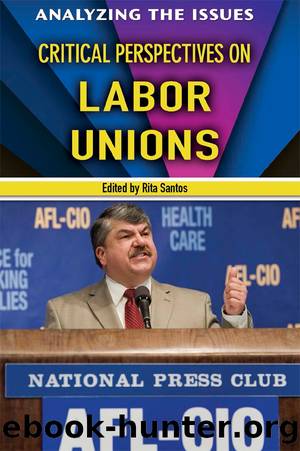Critical Perspectives on Labor Unions by Rita Santos

Author:Rita Santos
Language: eng
Format: epub
Publisher: Enslow Publishing, LLC
Published: 2019-08-27T00:00:00+00:00
2. What steps are fast food workers in Chicago taking to form their own union?
âMAY DAY AND THE FUTURE OF WORKERSâ INTERNATIONALISM,â BY LORENZO COSTAGUTA AND STEVEN PARFITT, FROM âNOTES FROM âWORKERS OF ALL LANDS UNITE?â CONFERENCE,â FROM THE BRITISH ASSOCIATION FOR AMERICAN STUDIES: U.S. STUDIES ONLINE, MAY 1, 2015
Almost 130 years ago, on May 1, 1886, hundreds of thousands of American workers responded to the call of a defunct organisation, the Federation of Organized Trades and Labor Unions, for a general strike demanding the eight hour working day. Three days later, an unknown person threw a bomb at police during a protest in Chicagoâs Haymarket Square. Eight anarchists were accused and convicted of conspiracy for that act. Four of them were eventually hanged, two were sentenced to death and had the sentence commuted, another committed suicide in prison and the eighth was given 15 years in jail. The Haymarket martyrs, as they became known, won wide sympathy for what was often seen as a colossal miscarriage of justice and an international campaign to secure their acquittal began. When the American Federation of Labor set May 1, 1890, as the date for renewed efforts to gain the eight hour day, they gained worldwide support from socialists, anarchists and trade unionists, many of whom had defended the Haymarket martyrs, and who marched in their millions on that day in all parts of the globe.
The idea of May 1, May Day, as a day celebrating international labour solidarity was born. From then, until now, men and women across the world have tried, with varying degrees of success, to maintain that tradition and uphold the principle that underlies it. However, that task seems more difficult than ever. The American labour movement actually organised a greater proportion of workers in May 1886 than it does today, and similar reverses have taken place in most of the so-called developed world. In the rest of the world trade unions have often scored major successesâmost recently, playing a major role in the downfall of the Egyptian dictator Hosni Mubarakâbut they have found it difficult to match the power of the global corporations that roam the world in search of cheap labour and amenable political clients. International migration, for all its many benefits, has often complicated efforts to unite workers in different countries against the power of global capital.
These challenges were at the centre of the event âWorkers of all lands unite? Working class nationalism and internationalism until 1945,â a conference organized by the Department of History and the Department of American and Canadian Studies at the University of Nottingham last March 7th, 2015, with the support of the Economic History Society. After a cursory glance at the programme, with academics from universities all over Europe delivering papers concerning the period before the Second World War, one could imagine the concepts of nationalism and internationalism as once major but now extinguished forces that shaped the past of working class movements. As the keynote address delivered by Dan Gallin made clear, however, this is hardly the case.
Download
This site does not store any files on its server. We only index and link to content provided by other sites. Please contact the content providers to delete copyright contents if any and email us, we'll remove relevant links or contents immediately.
Pale Blue Dot by Carl Sagan(4867)
Cracking the GRE Premium Edition with 6 Practice Tests, 2015 (Graduate School Test Preparation) by Princeton Review(4186)
Pocahontas by Joseph Bruchac(4100)
Unfiltered by Lily Collins(3932)
The Emotionary: A Dictionary of Words That Don't Exist for Feelings That Do by Eden Sher(3286)
The Daily Stoic by Holiday Ryan & Hanselman Stephen(3201)
Factfulness_Ten Reasons We're Wrong About the World_and Why Things Are Better Than You Think by Hans Rosling(3169)
The President Has Been Shot!": The Assassination of John F. Kennedy by Swanson James L(3025)
Sapiens and Homo Deus by Yuval Noah Harari(2950)
Rogue Trader by Leeson Nick(2950)
The 48 laws of power by Robert Greene & Joost Elffers(2898)
The Innovators: How a Group of Hackers, Geniuses, and Geeks Created the Digital Revolution by Walter Isaacson(2711)
The Rape Of Nanking by Iris Chang(2709)
Gettysburg by Iain C. Martin(2629)
Almost Adulting by Arden Rose(2626)
The Plant Paradox by Dr. Steven R. Gundry M.D(2518)
500 Must-Know AP Microeconomics/Macroeconomics Questions(2510)
In the Woods by Tana French(2502)
Make by Mike Westerfield(2261)
